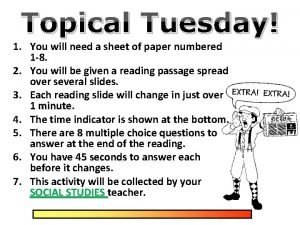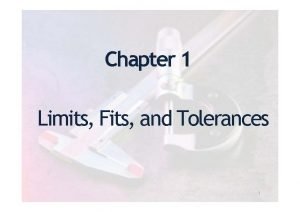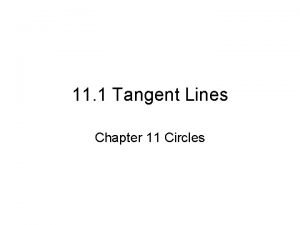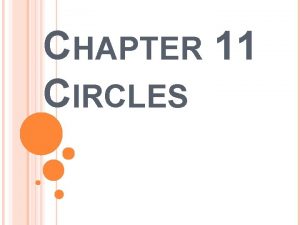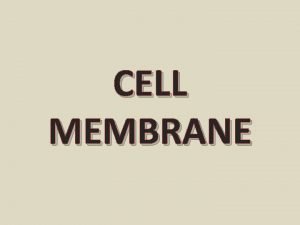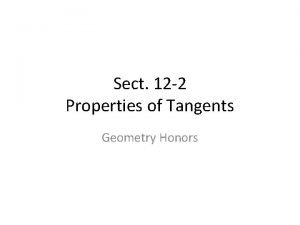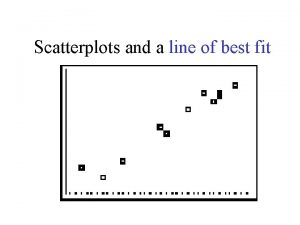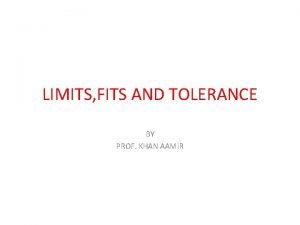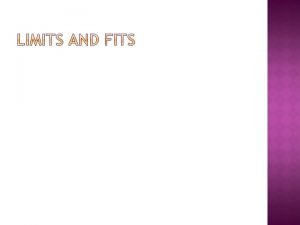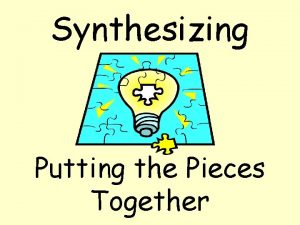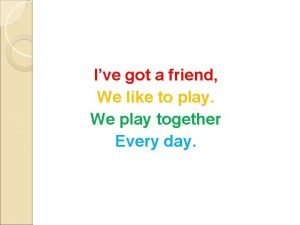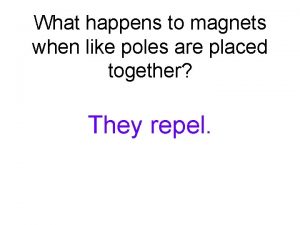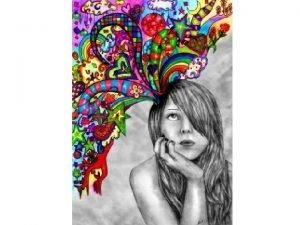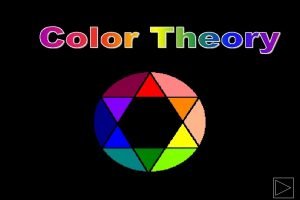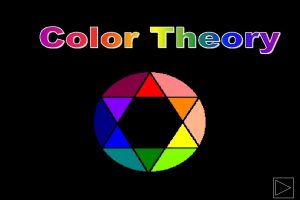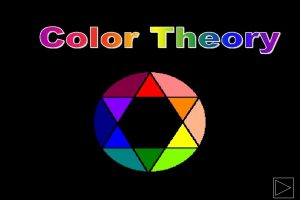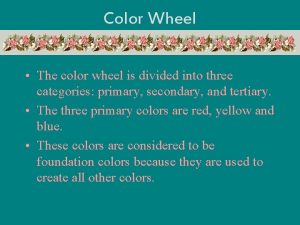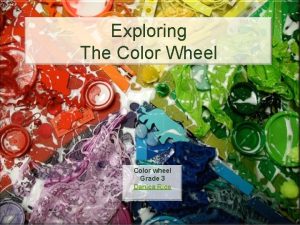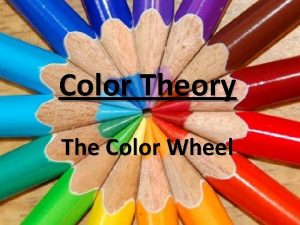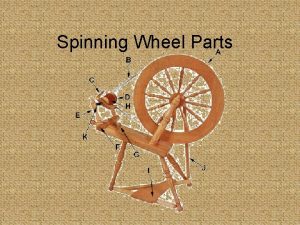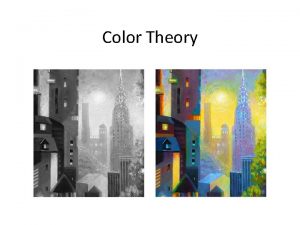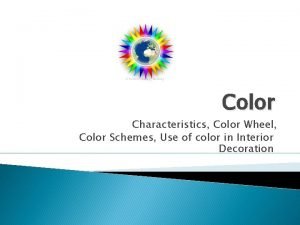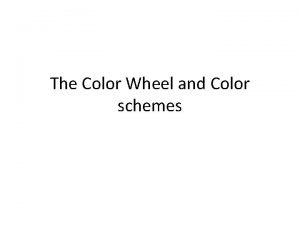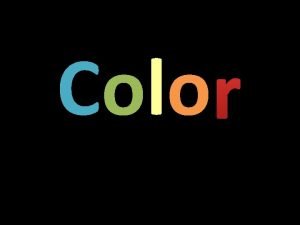Color Theory The color wheel fits together like


























- Slides: 26

Color Theory

• The color wheel fits together like a puzzle each color in a specific place. • Being familiar with the color wheel not only helps you mix colors when painting, but in adding color to all your art creations.

Primary Colors • Primary colors are not mixed from other elements and they generate all other colors. • Red • Yellow • Blue

Secondary Colors • By mixing two primary colors, a secondary color is created. • Red + Yellow = Orange • Yellow + Blue = Green • Blue + Red = Purple

Tertiary Colors • Intermediate, or Tertiary, colors are created by mixing a primary and a secondary. • red-orange • yellow-green • blue-green • blue-purple • red-purple

Warm • Warm colors are found on the right side of the color wheel. • They are colors found in fire and the sun. Warm colors make objects look closer in a painting or drawing.

• This is an illustration of the use of warm colors - reds, oranges and yellows.

Cool • Cool colors are found on the left side of the color wheel. • They are the colors found in snow and ice and tend to recede in a composition.

• Note the cool color scheme in this painting (greens, purples and blues).

Neutral Colors • The principles of color mixing let us describe a variety of colors, but there are still many colors to explore. • The neutral colors contain equal parts of each of the three primary colors. • Black, white, gray and sometimes brown are considered "neutral”.

• Color values are the lights and darks of a color you create by using black and white (‘neutrals”) with a color. This makes hundreds of more colors from the basic 12 colors of the wheel. • white + color = tint • color + black = shade

Tints • Tints are lightened colors. • Always begin with white and add a bit of color to the white until the desired tint is obtained. • This is an example of a value scale for the tints of blue.

Shades • Shades are darkened colors. • Always begin with the color and add just a bit of black at a time to get the desired shade of a color. • This is an example of a value scale for the shades of blue.

• Color Schemes are a systematic way of using the color wheel to put colors together… in your art work, putting together the clothes you wear, deciding what colors to paint your room…. . monochromatic, complementary, analogous, warm and cool.

Monochromatic • “Mono” means “one”, “chroma” means “color”… monochromatic color schemes have only one color and its values. • The following slide shows a painting done in a monochromatic color scheme.

• This non-objective painting has a monochromatic color scheme blue and the values (tints and shades) of blue.

Complementary • Complementary colors are opposite on the color wheel provided a high contrast - if you want to be noticed wear complementary colors!

• This painting has complementary colors and their values - blues and oranges.

Analogous • The analogous color scheme is 3 -5 colors adjacent to each other on the color wheel. • This combination of colors provides very little contrast.

• Analogous colors are illustrated here: yellow, yellowgreen, green and blue-green.

Painting Tips • When mixing paint ALWAYS add the dark colour to the light colour. • To make a colour more dull, add a bit of its complement (this is useful when painting shadows). • Clean your brush before changing colours.

Painting Tips • When mixing paint, use a dry brush and work quickly before the paint dries. • Only pour out/mix as much paint as you need for one class.

Painting Clean Up • Wash and dry your brushes after every class. Do not leave them in water. • Store clean, dry brushes in the proper containers with the bristles pointing up. • Pour unused paint into the proper containers and make sure the lids are fastened.

Painting Clean Up • All mixing trays must be cleaned, dried, and stacked neatly by the sink. • Tidy your table’s basket and put it back in the proper place at the end of class. • Make sure the sink is clean and empty before you leave. • Wipe your table with a damp cloth if it is messy.

Colour Symbolism Project • Complete these questions for each of the following colours: – What emotion/feeling does the colour represent for you? – Why? – List 3 things the colour reminds you of.

Colour Symbolism Project • • • Red Orange Yellow Green Blue Purple • • Grey Brown Black White
 Opvoedbelasting
Opvoedbelasting Chapter 74 ase questions
Chapter 74 ase questions Chapter 73 tire wheel and wheel bearing fundamentals
Chapter 73 tire wheel and wheel bearing fundamentals It is a slender tool attached in the needle bar
It is a slender tool attached in the needle bar Which fits best in the empty box above?
Which fits best in the empty box above? Strange fits of passion have i known
Strange fits of passion have i known Security that fits everywhere
Security that fits everywhere Limits fits and tolerances lecture notes
Limits fits and tolerances lecture notes Unilateral tolerance definition
Unilateral tolerance definition Find the value of
Find the value of Bilateral vs unilateral tolerance
Bilateral vs unilateral tolerance Decide whether each description fits trial courts only
Decide whether each description fits trial courts only Unit 10 homework 6 tangent lines
Unit 10 homework 6 tangent lines What does structure fits function mean
What does structure fits function mean What precautions best fits this pictogram
What precautions best fits this pictogram One size fits all
One size fits all Inductive learning
Inductive learning A belt fits tightly around two pulleys
A belt fits tightly around two pulleys The equation y=12.21x+37.42 fits the scatter plot
The equation y=12.21x+37.42 fits the scatter plot Allowance vs tolerance
Allowance vs tolerance Maximum clearance between hole and shaft formula
Maximum clearance between hole and shaft formula What is it in systems of fits
What is it in systems of fits After putting the pieces together, what do they look like?
After putting the pieces together, what do they look like? I've got a friend we like to play we play together
I've got a friend we like to play we play together What happens when like poles are placed together
What happens when like poles are placed together Hình ảnh bộ gõ cơ thể búng tay
Hình ảnh bộ gõ cơ thể búng tay Ng-html
Ng-html




